
Short Films to Save the Ocean, Part II: A Deeper Dive into the Effects of Climate Change on our Ocean
September 23, 2020Featured Image: Artwork from “What They Should Have Told Us” by Eliza Goodwin
In honor of the Global Day of Climate Action, we are featuring short student films from our Ocean Awareness Contest archives that investigate the many ways climate change affects ocean and human health.
These featured films focus on the connection between climate change and extreme weather events, rising sea level, ocean acidification, coral bleaching, and biodiversity loss. We also include films that portray humans as problem-solvers, which highlight our ability—and responsibility—to heal and care for our blue planet.
To view our entire collection of student visual art, writing, film, and music, visit our ocean advocacy gallery.
Click here for Part I of this series, which covers plastic pollution, oil spills, the climate crisis, and environmental activism.
If you have an idea for your own film, be sure to check out our 2021 Ocean Awareness Contest! The 2021 theme WATER RISING invites students ages 11-18 from around the world to create visual art, film, music, poetry, web-based media, music, or creative writing that explores their connection to water and creatively communicates the need to protect this vital resource.
Whether too much or too little, water is the primary way we will feel the effects of climate change. How do you feel the effects of climate change where you live? How will this change within your lifetime?
Jump to:
- Extreme Weather
- Coral Bleaching
- Sea Level Rise
- Ocean Acidification
- Biodiversity Loss
- Humans as Problem-Solvers
EXTREME WEATHER
Ainsley Cunningham (Age 14, New York)
Huracán
Discussion Questions:
- How are hurricanes tied to climate change? In particular, how do warming oceans contribute to more powerful hurricanes?
- Ainsley included footage from Hurricane Maria, which devastated Puerto Rico in 2017. How did watching this footage make you feel? What do you think it would have felt like to be in Puerto Rico during the storm?
- What happened after the storm ended that caused many more deaths in Puerto Rico?
Kendra Leigh Osias (Age 13, Philippines)
Mangroves: The Ocean’s Unsung Heroes
Discussion Questions:
- What extreme weather event occurred in Kendra’s home country of the Philippines? How did climate change contribute to this natural disaster?
- How do mangroves protect coastal communities from some of the effects of climate change?
- What are other natural benefits of mangroves?
- Kendra shares her personal story of survival within this larger disaster. How does focusing on one individual’s story help the audience connect to the larger topic of climate change?
Jay Gardoqui, William Bachelder & Evan Rankin (Age 15, Maine)
Between the Waves
Discussion Questions:
- Why did the filmmakers choose to focus on the economic impacts of extreme weather events? Do you agree with their reasoning?
- What are some of the estimated economic impacts of climate change and extreme weather events?
- What tips do the filmmakers provide to help slow climate change?
Biana Pinchuk (Age 16, Florida)
Featured Music Video: Rising
Discussion Questions:
- “Rising” is about a town that was severely affected by a bad storm, which was made all the worse because of the effects of climate change. How do sea level rise and the increased intensity of storms work in tandem to create more damage during extreme weather events?
- Biana, who is from Florida, sings from the point of view of a girl whose town is “dying.” Why might someone from Florida feel that their town is in danger of dying?
- Biana begins the song with the lyrics, “Hold my breath, holding my breath/I can’t breathe no more.” How do these words make you feel? How do these word choices relate to climate change?
Artist Spotlight: Meghna Unnikrishnan (Age 14, India)
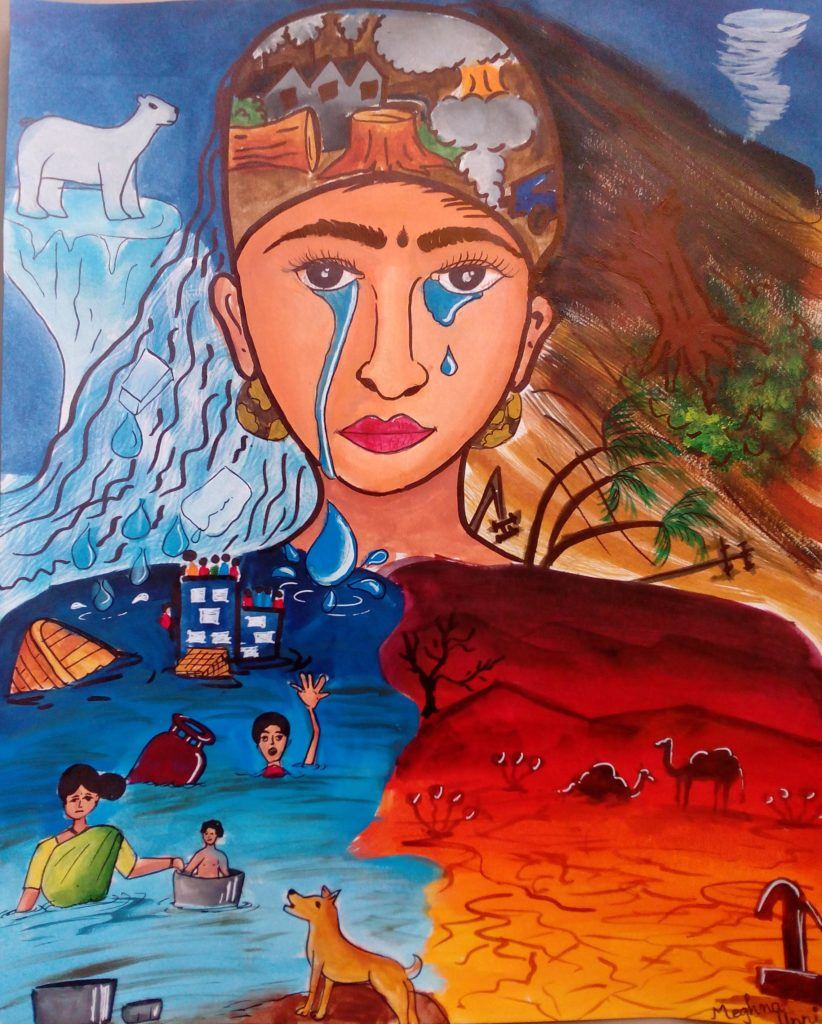
“Climate Change—Effects on Oceans & Living Things”
“Oceans in the changing climate are becoming a bad habitat for its lifeforms. Rising sea temperatures are causing extinction of some species of fish, coral reef, and other marine life. We are making our seas and oceans uninhabitable for marine plants and animals, and our land masses are fast evolving into garbage dumps. Rising sea levels are causing many coastal areas to be taken up by the sea. Hurricanes and floods are causing vast destruction to human life, too. The breaking of Arctic and Antarctic ice blocks at an alarming rate will cause loss of habitat to polar bears, penguins, seals and many such species. Ocean levels all over the world will increase, thereby taking many coastal cities underwater. Let’s hope something constructive is done by countries all around the world to contain climate change and save our planet.”
Student Spotlight: Grace Yang (Age 13, California)
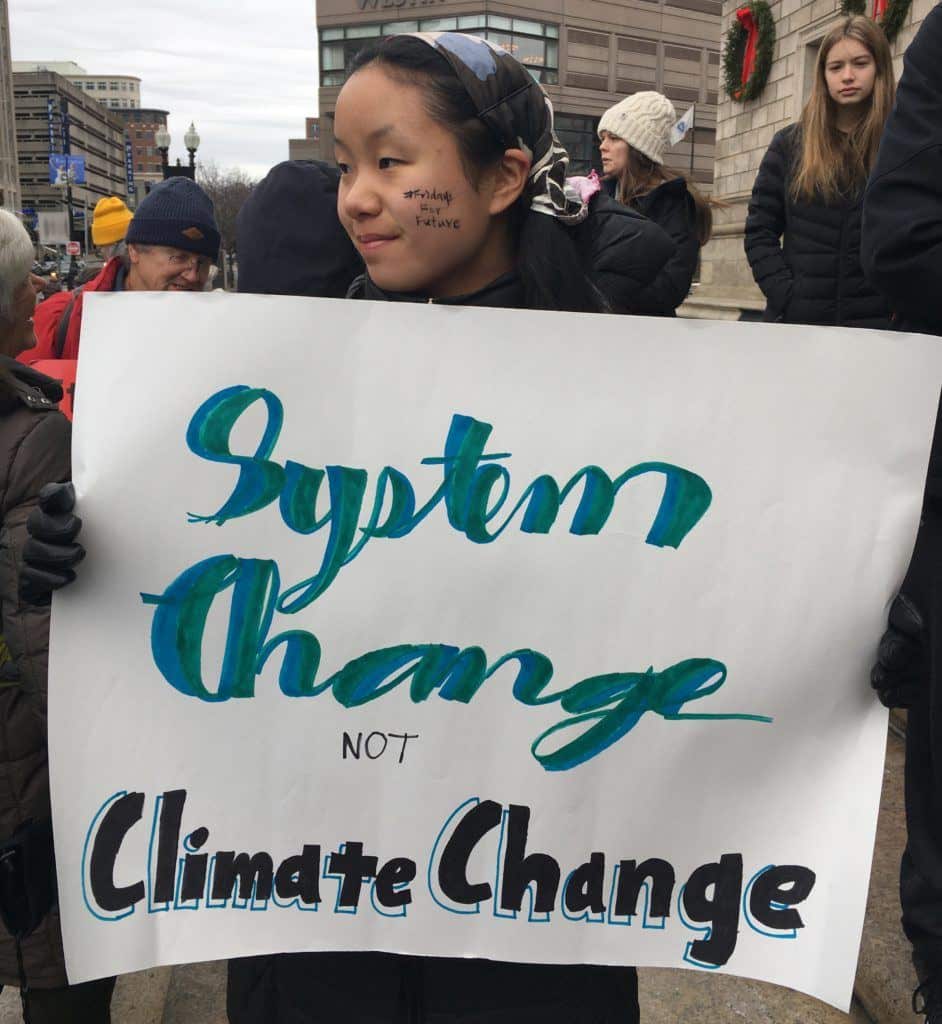
After winning a Silver Award for Junior Prose in the 2019 Ocean Awareness Contest, Grace Yang, an eighth grader from Lexington, Massachusetts, became a leader of Fridays For Future Massachusetts, a local chapter of Greta Thunberg’s youth-led global climate movement. Participating in the Contest inspired Grace to become active in the climate movement, as she actually followed in the footsteps of her own heroine in her short story, “2040”. In Grace’s words: “I learned that a young person’s vision for the future can come true because of the power of my generation. I wrote my story before I became a serious organizer with the climate movement, and writing about the future and what I was fighting for motivated me to be more involved.”
CORAL BLEACHING
Anna de Hostas Barth (Age 17, California)
Coral Bleaching
Discussion Questions:
- What is coral? (It’s not a plant, as many people think!)
- What are zooxanthellae, and how do they interact with coral?
- What is coral bleaching?
- What can we do to prevent coral bleaching?
Ainsley Cunningham (Age 15, New York)
A Future Less Vibrant
Discussion Questions:
- What thematic role does color play in Ainsley’s film? How is color “threatened” in the future?
- How are coral reefs important to the health of the ocean?
- What is the connection between global warming and coral bleaching? How are our carbon emissions tied to coral bleaching?
- What does the increased frequency of coral bleaching events signify?
Jenni Mangala (Age 15, North Carolina)
A Place Cooler Than Space
Discussion Questions:
- What details about coral reefs make Jenni claim they are “a place cooler than space”?
- How are coral reefs important to coastal communities and economies?
- Where in the world is coral bleaching most prevalent?
Colin Hutton (Age 14, Arizona)
Featured Music Video: At the Atoll
Discussion Questions:
Colin composed a mini-symphony with three movements that tell a story about coral reefs: “In the first movement of my piece, the listener is slowly immersed in the coastal habitat and discovers the beauty and grandeur of the coral reef. The slight transitions from major to minor chords represent gentle breakers lapping on the shore. The second movement introduces all the different characters living in the reef as they assemble for a dance. The more melancholy feel of the third movement is due to the tragic abundance of coral bleaching in reefs all around the world. Here, the piece transitions as if all of the inhabitants of the reef are pleading to us humans to fix the damage we have caused to their home after showing us the importance and the wonder of the coral reef.”
- How does each movement of the mini-symphony make you feel? What images come to mind?
- Why is music an effective medium to bring about social change?
Artist Spotlight: Mackenzie Martin (Age 18, Maine)
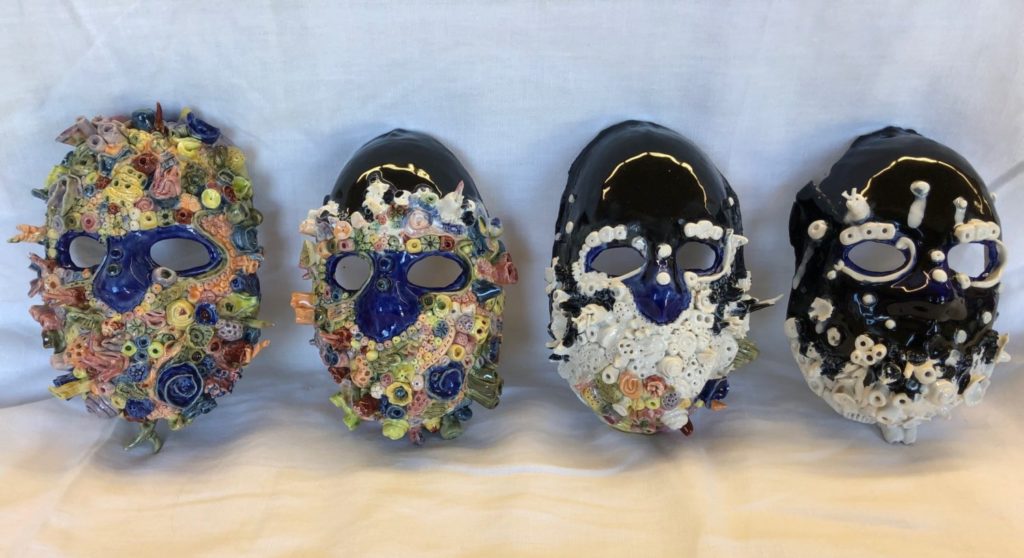
“Self-Destruction”
“Self-Destruction is a progressive representation of human impact on our coral reefs. Coral bleaching is presented on a human face to show the connection and impact of our footprint on oceans and coral populations. The first mask shows what corals looked like before climate change started impacting their environment. The second and third masks show the gradual decline in coral life. The final mask, which is completely deprived of living coral, is what our coral reefs will look like if we continue to ignore climate change and refuse to change our ways. Today coral bleaching—the term used to define when algae leave the coral, which often leads to death—is destroying coral environments all over the globe. Its relevance is only becoming more apparent with the rising of Earth’s temperatures. I am currently pursuing a degree in marine biology, making this an even more important issue to me. Solving this problem is going to take the efforts of many, all around the world. It’s easy to feel helpless and small when trying to make a difference, but making this piece has given me a voice. Self-Destruction has allowed me to bring awareness to climate change and what humans are doing to our corals and to ourselves.”
SEA LEVEL RISE
Leah Burkhardt (Age 18, Maryland)
Climate Change and the Chesapeake Bay
Discussion Questions:
- Why is the Chesapeake Bay particularly vulnerable to sea level rise?
- What are dead zones, and how does sea level rise increase the likelihood of these zones in the Chesapeake Bay?
- How does sea level rise affect the local economy in places like Annapolis, Maryland?
Poulami Soni & Amritha Karthikeyan (Age 16, Arizona)
the sea is rising and so are we
Discussion Questions:
- How did climate change contribute to the level of flooding in Kerala?
- How does sea level rise harm coastal habitats?
- What are the various effects of melting glaciers on the ocean?
- How are climate refugees connected to sea level rise?
Sophie Fyfe (Age 18, California)
The Oceans are Coming
Discussion Questions:
- Sophie uses dance and poetic narration to express her worries about climate change and sea level rise. Can you identify particular movements within Sophie’s dance that deepen the meaning of the words?
- Why do you think Sophie chose to end the dance in a curled up position? What is the symbolic meaning of this movement?
- What is the overall feeling created by this dance film? What elements of the dance, music, and narration make you feel this way?
John Paul Rabusa (Age 18, Arizona)
Featured Music Video: Rising Seas
Discussion Questions:
- John Paul is from Phoenix, Arizona, a landlocked part of the United States. What reasoning does John Paul give for why we should care about the effects of climate change on the ocean, even if we do not live near it?
- How do increasing sea temperatures contribute to sea level rise?
- What is another way that climate change causes sea level rise?
- What are some things you can do to prevent sea level rise?
Artist Spotlight: Emily Tan (Age 12, Singapore)
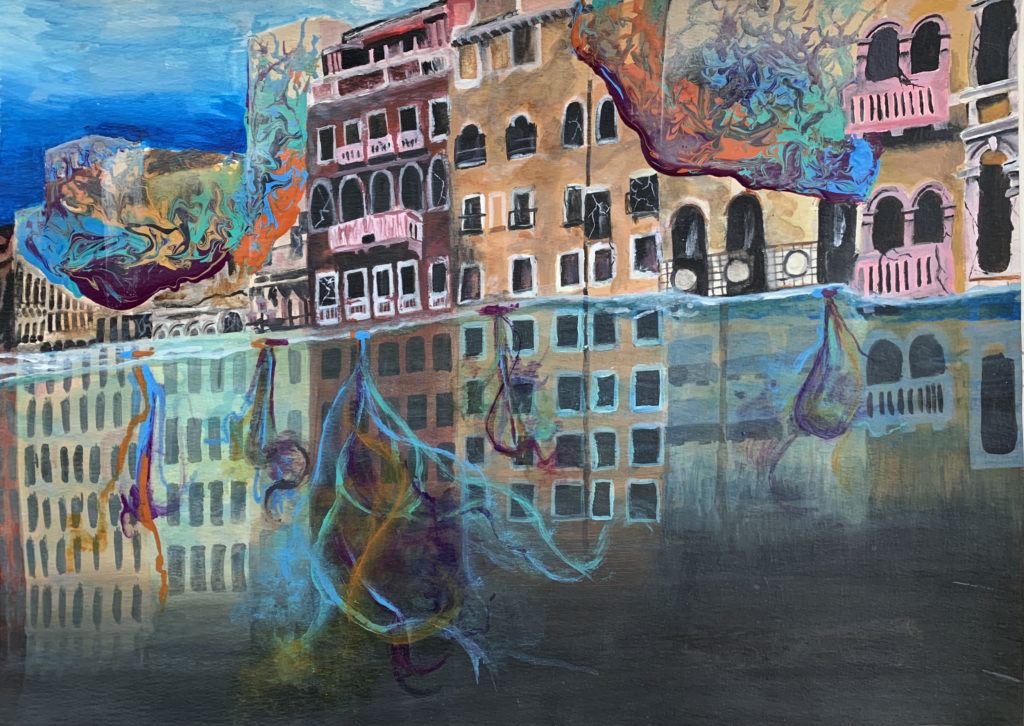
“The Sinking City”
“Today, global warming is becoming a more pressing problem. Due to rising temperatures, polar ice caps are melting and sea levels are rising. The rising sea levels threaten to engulf low-lying coastal cities. Venice is one such city. Year after year, more of the city falls below the sea level, and that is why it is called the sinking city. My hometown Singapore is a tiny island that also faces the threat of being swallowed by water. If we do not acknowledge the problem of global warming, sea levels will continue to rise and people such as myself will lose their homes. In my artwork, I’ve painted a scene of Venice. Part of the city is underwater and the buildings are in disrepair because the city has been evacuated. There is also a coat of oil on the buildings and oil in the water because water pollution is another serious environmental issue threatening our seas and coastal cities. We need to protect our waters for the people who live near the seas and oceans; we need to protect their homes.”
OCEAN ACIDIFICATION
Rashib Nair & Monish Ramesh Jayakumar (Age 12, Massachusetts)
A Sea of Troubles
Discussion Questions:
- How do carbon dioxide emissions(CO2) cause the earth to warm? Where does much of this CO2 end up?
- When CO2 enters the ocean, how does it impact the shellfish?
- What happens when the shellfish do not have enough calcium?
- What feeling is created by Rashib and Monish’s choice of music to open the film?
Liam Douglas & Nate Stauffer (Age 14, Pennsylvania)
Ocean Acidification
Discussion Questions:
- What is ocean acidification and how is this phenomenon connected to climate change?
- What kinds of marine life are most vulnerable to ocean acidification? Why?
- How does ocean acidification affect the entire oceanic food web?
- What can you do to prevent ocean acidification?
Saighuhan Senthilkumar (Age 16, Virginia)
Acidification of the Oceans
Discussion Questions:
- In his film, Saighuhan states that historically, the pH level of the ocean has been basic, with an average pH of 8.2. That pH has dropped to 8.1. Though this decrease sounds small, what kind of change does this represent in our ocean?
- What is the effect of this increased ocean acidity on oysters, a species particularly important to waters of the Chesapeake Bay where Saighuhan lives?
- Saighuhan ends his film with a saying by Robert Swan: “The greatest threat to our planet is the belief that someone else will save it.” What does this quote mean, and what does it encourage you to do?
Sydney Sadler (Age 18, Arizona)
Featured Music Video: Acidified
Discussion Questions:
- What is the mood of Sydney’s song? How does this mood make you feel?
- How might ocean acidification affect the fishing industry?
- How does society’s dependence on fossil fuels connect to ocean acidification?
- How can voting and sharing information help prevent acidification and climate change?
Artist Spotlight: Alisa Matveeva (Age 13, New York)
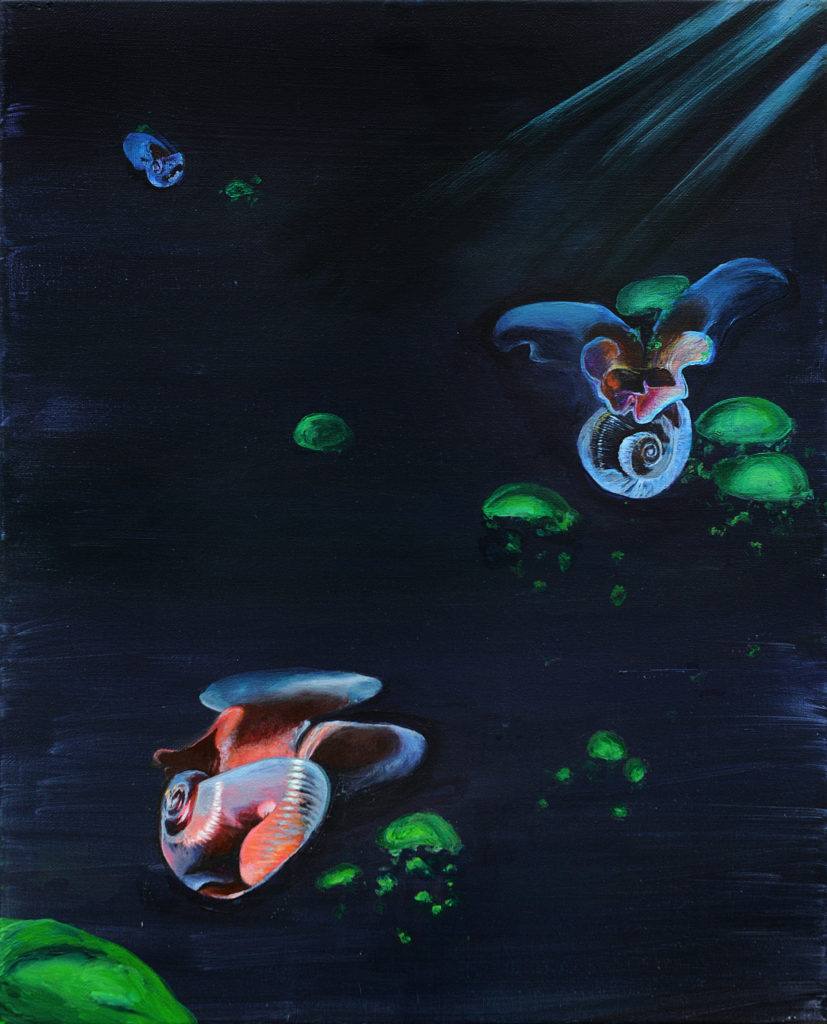
“The Dissolving Bright”
“When thinking of climate change, people usually think of big things like ocean warming or glaciers melting. But they never think of how climate change affects small creatures that live in the ocean. In this case, sea butterflies are an example of smaller, lesser known living creatures that are impacted by ocean acidification and climate change. Through my research, I learned that ocean acidification occurs when carbon dioxide gas is absorbed by the ocean and reacts with sea water to produce acid. This acid dissolves the creatures’ shells, which they are then unable to remake. Without their shells, they cannot survive. A study showed that since the pre-industrial era, the percentage of sea butterflies with dissolving shells has doubled. That’s expected to triple by 2050. In my artwork, I painted three sea butterflies to represent the three main results of climate change: temperatures rising, ocean acidification, and glacier melting.”
BIODIVERSITY LOSS
SydneyBlu Garcia-Yao (Age 13, Pennsylvania)
Threatened
Discussion Questions:
- How does climate change threaten Atlantic salmon?
- How do rising sea temperatures throw off salmons’ natural cycles?
- SydneyBlu uses elements from the horror genre in her film. Why might she have made this choice? Why is horror an appropriate genre to highlight the effects of climate change on fish?
Eliza Goodwin (Age 17, Maine)
What They Should Have Told Us
Discussion Questions:
- What issues does Eliza focus on?
- Why might Eliza have chosen to place these images in a television? What statement is she making about the media?
- What is the significance of the 1950’s style of the set decoration?
- What type of audio plays over the ending credits? What critique is Eliza making with this audio?
Olivia Griffin (Age 15, North Carolina)
Featured Music Video: Change the Sea Turtles’ Fate
Discussion Questions:
- How are green sea turtles helpful to the ecosystem?
- How does climate change affect ocean currents? How do these changing currents adversely affect green sea turtles?
- What is the effect of the warming climate on sea turtle eggs? Why is this problematic?
- According to Olivia, what three things can we do to change sea turtles’ fate?
Artist Spotlight: Anastasiia Korolevskaia (Age 17, Florida)

“Change”
“During early childhood, I spent countless summers in the rural areas of Russia, surrounded by vast, intimidating forests and crystal lakes. Enjoying a pleasant life detached from most technology, overwhelmed by the magnificent beauty of the natural world, I had plenty of time to form a spiritual connection with nature and reflect on man’s relationship with it, a theme that prevails in this work. While creating this piece, I strove to accentuate the delicacies and fragility of the natural world despite its grand, magnificent appearance by focusing my efforts primarily on elaborate detail, vulnerable to even the slightest mistake or imperfection in the guidance of the artist’s hand. Humanity’s relationship with nature is itself similar to an artist crafting their masterpiece: great care and vast attention to the larger picture is necessary for all aspects of the image to achieve stability and harmony. Man too must be careful in his actions against the environment, keeping in mind the tremendous scope of all consequences, lest there be dissonance and irreversible damage done to the natural balance in the future. However, as I completed my work, I realized that the future arrives sooner than anticipated. In our continuously developing world, it is important that people continue nurturing their connection to nature, whether through personal exposure or art, so that they come to comprehend its value and cultivate a desire to protect it.”
HUMANS AS PROBLEM-SOLVERS
Kalea Holdren, Ursula Junker, Sadie Leveque, Petra Brienza & Meredith Kinkade (Age 13, Massachusetts)
Symbiosis: Humans of the Sea
Discussion Questions:
- In “Symbiosis: Humans of the Sea,” the filmmakers ruminate on what the ocean has given us. What are some of the experiences they describe? What are some experiences the ocean has given you?
- Throughout the film, the ocean is referred to as “she”; what is the emotional effect of using this pronoun to refer to the ocean?
- The filmmakers make the following statement about the ocean: “She knows only how to help others and relies on those she helps when she is in need of saving.” What do you think about this statement? What can we do to help the ocean?
- What is the significance of the girls covering their eyes and ears? What are they trying to say about humanity?
Georgia Lingerfelt (Age 16, Georgia)
A New Day
Discussion Questions:
- What is the significance of the story Georgia shares about picking up the hermit crab? How does she connect this personal event to the larger problem of climate change?
- What kinds of personal choices does Georgia highlight which can lessen the harmful effects of climate change?
- “A New Day” concludes with an upbeat montage of scuba diving footage and marine life, followed by a descent into a sunken vessel. What might Georgia be saying with this juxtaposition of images in the final moments of the film?
Raúl Falcón (Age 16, Puerto Rico)
Future Oceans
Discussion Questions:
- What is the significance of the clasped hand imagery throughout the film?
- Starting at 1:20, the film shifts from reciting the problems caused by climate change to a sort of love poem to our ocean. What are some reasons Raul loves the ocean? What are some reasons you love the ocean?
- To save our ocean, Raul speaks about the importance of words. Why does he think words are important? Do you agree?
Lilly Chertock (Age 15, California)
Featured Music Video: For Their Sake
Discussion Questions:
- Lilly sings, “I’m not gonna sit back and watch you debate.” What debates do you think Lilly is referring to and why might someone not want to engage in these debates?
- In the chorus, Lilly sings that she is “gonna strike”; how might striking be a means of solving the climate crisis?
- How might we “get our priorities straight”?
Artist Spotlight: Ana Joo & Olivia Jin (Age 13, California)
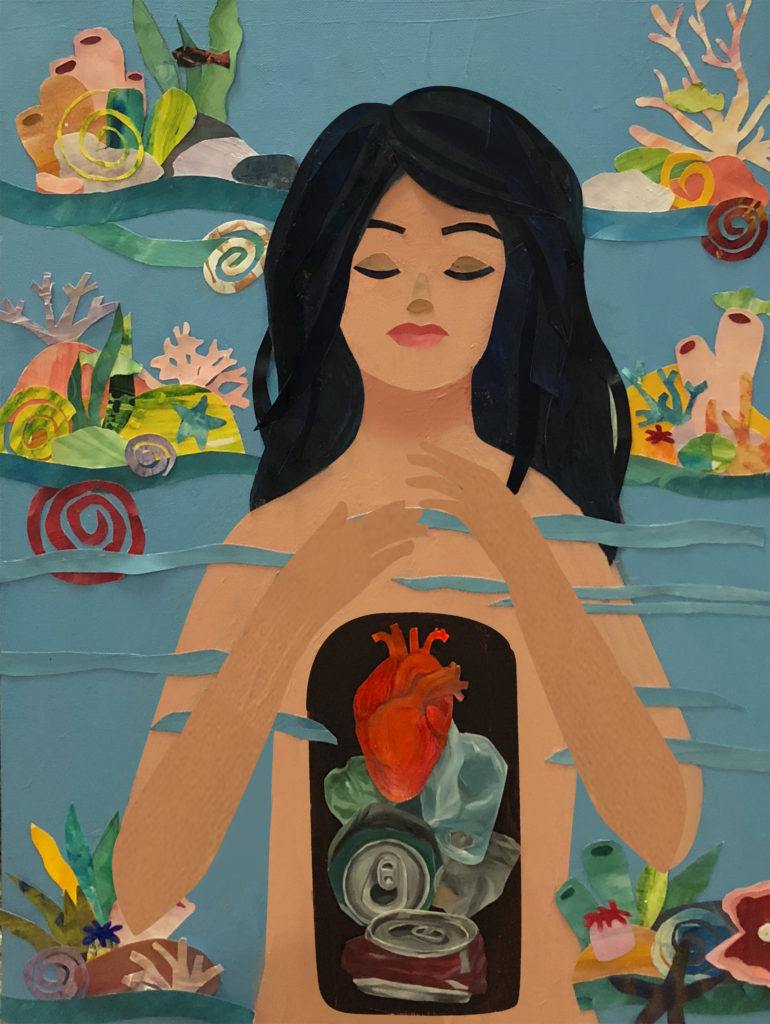
“Mother Earth”
“This painting was created to spread insight and, hopefully, inspire others to take actions against man-created disasters such as ocean pollution and climate change. We were inspired to do this project after going through different images and writings and using multiple resources to decide on the best idea. The trash and grime in the human body represent the way we affect our surroundings and affect ourselves as well. The heart is brighter than the rest of the body to show that there is hope for us to become involved and to do better for the environment. The dazzling coral represents how, with a willing heart, anything is possible. Overall, the ending achievement is the recognition that if you change your mindset and your heart, anything you set your mind to is possible.”
TAKE ACTION
What can you do to help slow the climate crisis?
- Apply pressure. Large corporations are the biggest polluters on Earth, and until they are required to drastically decrease their greenhouse gas emissions, it will be difficult for real change to occur. Through collective action—like strikes, marches, petitions, art movements, and educational events—we can put pressure on corporations and governments to require and implement real systemic change.
- Keep learning and sharing your knowledge with others. It is important to learn about the latest science and potential solutions, including renewable energy sources, technology, and policy solutions. Studies show that people’s “family and friends have the greatest ability to convince them to take action to reduce global warming,” so have conversations with your loved ones and let your voice be heard in your community–you can make a real difference!
- Connect with nature. Whether you live in the country or the city, get outdoors and enjoy our beautiful blue planet.
Vote. If you are 18 or older, vote for climate leaders in your local, state, and federal elections. If you are under 18, educate the adults in your life and let them know what you think and how you feel. You can join our Voteless Not Voiceless campaign, where “voteless” youth (ages 13-17) from the U.S. are invited to share their stories about environmental issues that impact them, and inspire voters to cast their ballot with the future of our blue planet in mind. For every story received, we make a $10 donation to our campaign partner Our Climate, so your voice equals direct impact by educating and registering climate voters this fall. - Work to end racism. Black and brown people are disproportionately more affected by the climate crisis, and polling shows that they are also more concerned about climate change; however, the environmental movement has predominantly been run by and targeted towards white people. This needs to change. Our movement needs the insight, expertise, and talents of black and brown people. People of color need to be included in making decisions about the environmental movement and discussions about solutions to the climate crisis.
